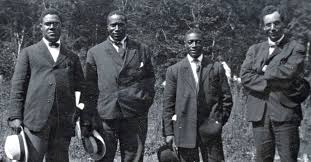A Bum Bum Bum Bum Bum Bum Jubileeeee!
Although African American slaves did not have the means or resources to archive or document cultural traditions, they developed a non-material culture to be passed down
to later generations. The concept of oral tradition as a non-material culture illustrates the legacy of secular music and creativity of African Americans as a whole. During
slavery, African American slaves sang about God and their struggles as they worked. By singing, slaves were generating a platform for their culture; a form of resistance
that could not be erased.
In continuation of this legacy, jubilee quartets, an a cappella ensemble of four to six performers, varied in its existence and developed numerous subcategories during the
Transitional Period (1930-1945). For example, there were university, minstrel, community-based, shape-note, and barbershop quartets. Despite the different
subcategories, jubilee quartets were widely popular among Black colleges like Fisk University, Hampton Institute, Morehouse College, Tuskegee Institute, and many more.
These university quartets utilized their spiritual and secular arrangements to pursue funding and financial stability.






